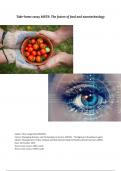Take-home essay MSTS: The future of food and nanotechnology
Author: Yara Langeveld (2760223)
Course: Managing Science and Technology in Society (MSTS) - Workgroup 3 (Jonathan Luger)
Master: Management, Policy Analysis and Entrepreneurship in Health and Life Sciences (MPA)
Date: 16 October 2023
Word count essay 1: 1091 words
Word count essay 2: 1096 words
, Essay 1: Public engagement with food
Co-creating the future of sustainable food
Global food security and biodiversity conservation have become grand societal challenges
worldwide due to the effects of climate change and the continuously growing population2. As a
result, a transition of the global food system towards a more sustainable, fair and
environmentally-friendly system and consumption practices is required. To stimulate such a
transition and create a lasting impact, public engagement (PE) is very important. This involves the
interaction and dialogue between a wide variety of stakeholders, such as policymakers,
scientists, innovators, academics, the industry and the public, with the aim of creating a mutual
understanding4,8. Through this, mutually beneficial solutions for grand societal challenges, such
as global food security and biodiversity conservation, can be co-created in an inclusive and
participatory way with all those involved in and affected by it4. Within this essay, four ways of PE
are outlined and connected to the sustainable food transition. Furthermore, it is explained how
PE is an essential part of responsible research and innovation (RRI), and therefore pivotal in the
policy development for the global food system.
PE is a broad term, concerning the democratisation of knowledge and policy development
through including a variety of stakeholders11. Overall, four types of PE are distinguished:
informing, consulting, deliberating and co-creating7. Informing public engagement entails a
one-way information dissemination from the government to the public, whereby the government
shares information to create awareness, but there are limited opportunities for the public to
influence the final outcome. This is exemplified by the “Farm to Fork” strategy of the European
Commission. This strategy contains a legislative framework to enable sustainable food supply
and security, and raises awareness among a wide range of stakeholders3. However, there is little
to no opportunity for these stakeholders to influence the eventual policies that are supposed to
support the food transition. They simply have to accept and apply the policies offered by the
European Union (EU). Consulting public engagement also forms a one-way information
dissemination strategy, but instead, from the public to the government7. This is a form of
contributory citizen science, as the government collects the public’s desires, ideas and
recommendations to understand their opinions on topics and use this for policy-making9,11. For
instance, the European Institute of Innovation and Technology (EIT), co-founded by the EU, has
initiated a “Proof of Concepts” call, which is an open call where people can leave their ideas for a
sustainable, safe and healthy food system5. These ideas can subsequently be tested with funding
of the EU. Thereby, they create an opportunity for the public to influence the research and
policy agenda. Deliberating public engagement is a two-way, information exchange type of PE, in
which topics are discussed with different types of stakeholders in small groups to understand
their views, and at the same time share ideas of policy-makers7,9. Van Oudheusden et al.11 called
this participatory citizen science, as citizens are included in scientific and policy research
activities. An example of this is the German “Nutrition in Transition” citizen’s assembly. Hereby,
160 randomly selected inhabitants were invited by the German parliament to discuss their ideas
for a healthier and more sustainable food system1. Through this, the German parliament,
scientists and academic experts learned about the expectations of citizens and at the same time
could discuss these expectations and provide information in return. Finally, co-creating public
engagement entails that stakeholders collaboratively develop solutions for complex problems and
implement them, thereby being involved in all levels of research and policy-making7,9,11. This is





